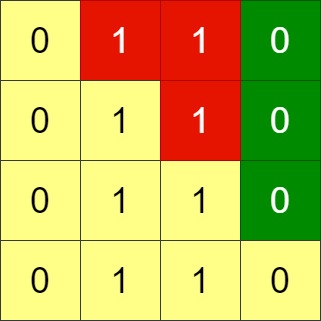Minimum Swaps to Arrange a Binary Grid
Given an n x n binary grid, in one step you can choose two adjacent rows of the grid and swap them.
A grid is said to be valid if all the cells above the main diagonal are zeros.
Return the minimum number of steps needed to make the grid valid, or -1 if the grid cannot be valid.
The main diagonal of a grid is the diagonal that starts at cell (1, 1) and ends at cell (n, n).
Example 1:

Input: grid = [[0,0,1],[1,1,0],[1,0,0]]
Output: 3Example 2:

Input: grid = [[0,1,1,0],[0,1,1,0],[0,1,1,0],[0,1,1,0]]
Output: -1
Explanation: All rows are similar, swaps have no effect on the grid.Example 3:

Input: grid = [[1,0,0],[1,1,0],[1,1,1]]
Output: 0Constraints:
n == grid.lengthn == grid[i].length1 <= n <= 200grid[i][j]is0or1
class Solution {
public int minSwaps(int[][] grid) {
int n = grid.length;
Map<Integer, int[]> map = new HashMap<>();
Set<Integer> set = new HashSet<>();
for (int k = n - 1; k > 0; k--) {
int flag = 0;
for (int i = 0; i < n; i++) {
int count = 0;
for (int j = n - 1; j >= 0; j--)
if (grid[i][j] == 0)
count++;
else
break;
if (count >= k && !set.contains(i)) {
flag = 1;
set.add(i);
map.put(k, new int[]{n - (k + 1), i});
break;
}
}
if (flag == 0)
return -1;
}
int count = 0;
for (int k = n - 1; k > 0; k--) {
int pos = map.get(k)[1];
int dest = map.get(k)[0];
count += Math.abs(pos - dest);
if (pos > dest) {
for (int x : map.keySet()) {
if (map.get(x)[1] >= dest && map.get(x)[1] < pos)
map.get(x)[1]++;
}
} else if (pos < dest) {
for (int x : map.keySet()) {
if (map.get(x)[1] > pos && map.get(x)[1] <= dest)
map.get(x)[1]--;
}
}
}
return count;
}
}Last updated